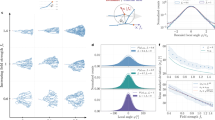Abstract
A mathematical model of the forces and deformations of the tissues involved in branching morphogenesis is developed and solved. The epithelium and mesenchyme are modeled as Stokes fluids separated by an interface. Each fluid is assumed to have constant viscosity. An initially 3-lobed rudiment is deformed by three inwardly directed point forces. Relationships between the physical parameters of the model (tissue viscosity, clefting force, surface tension) and the time course and morphology are explored. We find that the surface tension, clefting force, and viscosity ratio of the two tissues have significant effects on the branching. We conclude that epithelial branching in soft gels is fundamentally different from epithelial branching in mesenchyme, because of the different mechanics. We propose that a complete understanding of branching morphogenesis requires measurements of the mechanical aspects.
Similar content being viewed by others
Author information
Authors and Affiliations
Additional information
Received: 5 October 2001 / Accepted: 19 November 2001
Rights and permissions
About this article
Cite this article
Lubkin, S., Li, Z. Force and deformation on branching rudiments: cleaving between hypotheses. Biomechan Model Mechanobiol 1, 5–16 (2002). https://doi.org/10.1007/s10237-002-0001-4
Issue Date:
DOI: https://doi.org/10.1007/s10237-002-0001-4




